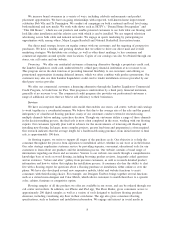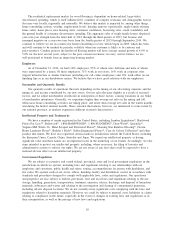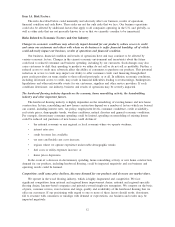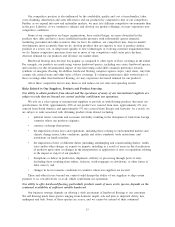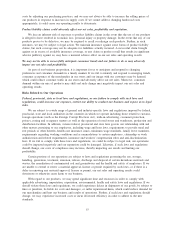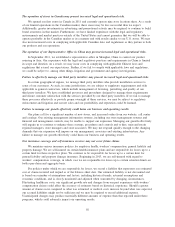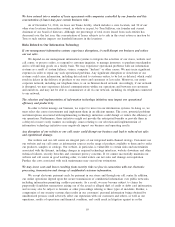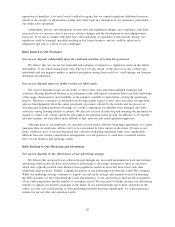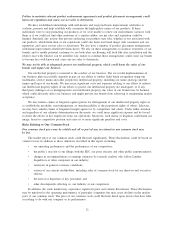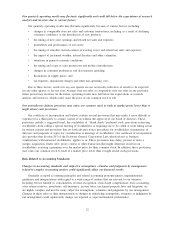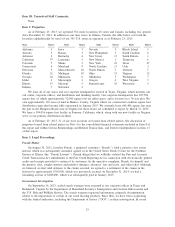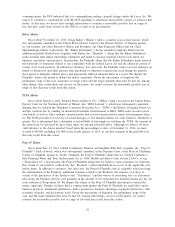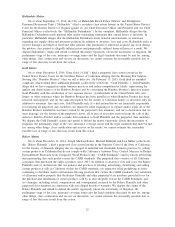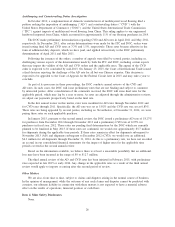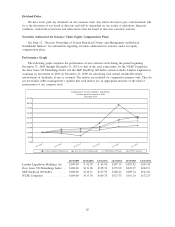Lumber Liquidators 2014 Annual Report Download - page 26
Download and view the complete annual report
Please find page 26 of the 2014 Lumber Liquidators annual report below. You can navigate through the pages in the report by either clicking on the pages listed below, or by using the keyword search tool below to find specific information within the annual report.The operation of stores in Canada may present increased legal and operational risks.
We opened our first stores in Canada in 2011 and currently operate nine store locations there. As a result
of our limited operations in the Canadian market, these stores may be less successful than we expect.
Additionally, greater investments in advertising and promotional activity may be required to continue to build
brand awareness in that market. Furthermore, we have limited experience with the legal and regulatory
environments and market practices outside of the United States and cannot guarantee that we will be able to
operate profitably in the Canadian market or in a manner and with results similar to our U.S. stores. We may
also incur increased costs in complying with applicable Canadian laws and regulations as they pertain to both
our products and our operations.
The operation of our Representative Office in China may present increased legal and operational risks.
In September 2011, we established a representative office in Shanghai, China to control our product
sourcing in Asia. Our experience with the legal and regulatory practices and requirements in China is limited
in scope and duration. As a result, we may incur costs in complying with applicable Chinese laws and
regulations that exceed our expectations. Further, if we fail to comply with applicable laws and regulations,
we could be subject to, among other things, litigation and government and agency investigations.
Failure to effectively manage our third party installers may present increased legal and operational risks.
In certain geographical regions, we manage third party installers who provide installation services to
some of our customers. As such, in some jurisdictions, we are subject to regulatory requirements and risks
applicable to general contractors, which include management of licensing, permitting and quality of our
third party installers. We have established processes and procedures designed to manage these requirements
and ensure customer satisfaction with the services provided by our third party installers. If we fail to manage
these processes effectively or provide proper oversight of these services, we may be subject to regulatory
enforcement and litigation and our net sales and our profitability and reputation could be harmed.
Failure to manage our growth effectively could harm our business and operating results.
Our plans call for a significant number of new stores, and increased orders from our website, call center
and catalogs. Our existing management information systems, including our store management systems and
financial and management controls, may be unable to support our expansion. Managing our growth effectively
will require us to continue to enhance these systems, procedures and controls and to hire, train and retain
regional managers, store managers and store associates. We may not respond quickly enough to the changing
demands that our expansion will impose on our management, associates and existing infrastructure. Any
failure to manage our growth effectively could harm our business and operating results.
Our insurance coverage and self-insurance reserves may not cover future claims.
We maintain various insurance policies for employee health, workers’ compensation, general liability and
property damage. We are self-insured on certain health insurance plans and are responsible for losses up to a
certain limit for these respective plans. We continue to be responsible for losses up to a certain limit for
general liability and property damage insurance. Beginning in 2013, we are self-insured with regard to
workers’ compensation coverage, in which case we are responsible for losses up to certain retention limits on
both a per-claim and aggregate basis.
For policies under which we are responsible for losses, we record a liability that represents our estimated
cost of claims incurred and unpaid as of the balance sheet date. Our estimated liability is not discounted and
is based on a number of assumptions and factors, including historical trends, actuarial assumptions and
economic conditions, and is closely monitored and adjusted when warranted by changing circumstances.
Fluctuating healthcare costs, our significant growth rate and changes from our past experience with workers’
compensation claims could affect the accuracy of estimates based on historical experience. Should a greater
amount of claims occur compared to what was estimated or medical costs increase beyond what was expected,
our accrued liabilities might not be sufficient and we may be required to record additional expense.
Unanticipated changes may produce materially different amounts of expense than that reported under these
programs, which could adversely impact our operating results.
18


